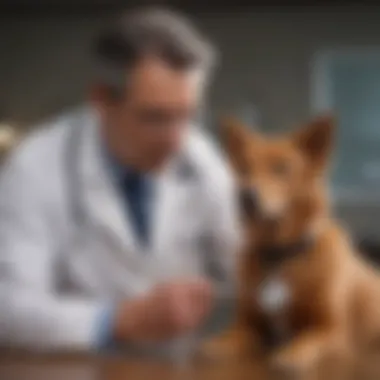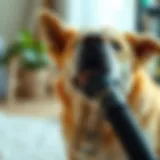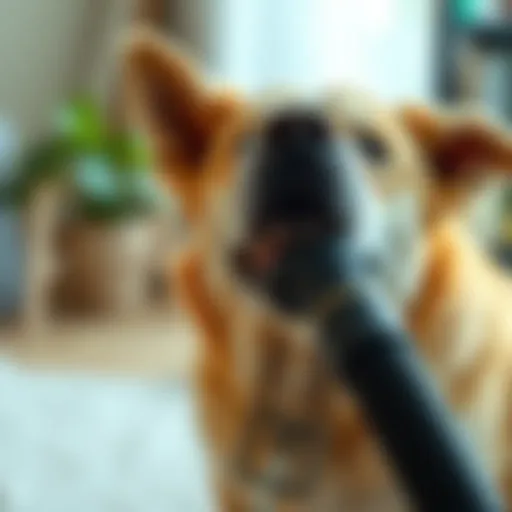Effective Treatments for Dog Appetite Loss


Intro
Loss of appetite in dogs is a concern that many pet owners encounter at some point. It can stem from various causes, including health issues or stress. This guide aims to delve into the treatments available for dogs experiencing a lack of interest in food. Understanding the reasons behind this behavior is essential for addressing it effectively.
Pet Care Essentials
Feeding your dog requires careful attention to various factors that contribute to their overall well-being. When a dog refuses food, assessing their daily routines can provide insight into underlying issues.
Daily Nutrition Requirements
Proper nutrition is vital for maintaining a dog's health. Each dog has unique dietary needs that can vary based on their age, size, breed, and lifestyle. Consult your veterinarian to establish an appropriate feeding schedule and food type. Factors include:
- Age of the dog;
- Activity level;
- Specific health conditions.
Choosing high-quality dog food with balanced nutrients will help ensure that your pet has the energy they need and might even spark their interest in eating. Pay attention to ingredient quality and avoid fillers that do not contribute to their health.
Exercise and Playtime
Engaging your dog in regular physical activity not only keeps them fit but also encourages a healthy appetite. A daily routine that includes walks, fetch, or interactive play can stimulate their senses and promote a positive state of mind. Consider the following activities:
- Long walks;
- Tug-of-war games;
- Agility training.
Exercise can have a direct impact on your dog’s desire to eat by helping them relieve stress and expend energy.
Grooming Tips
Proper grooming plays a role in a dog’s overall comfort and health. Regular brushing helps remove dead hair and promotes a healthy coat. Check for signs of skin issues or parasites, which may contribute to a dog's reluctance to eat. Bathing should be kept at regular intervals to avoid skin irritations.
Health and Wellness Check-ins
Routine wellness check-ins with your vet are crucial in spotting potential health issues early. Many health problems can affect a dog’s appetite. Schedule regular appointments and discuss any changes in eating habits with your vet, as early intervention can lead to better outcomes.
Behavior & Training
Understanding your dog’s behavior can offer critical insights into their appetite issues. Behavioral changes can significantly affect their interest in food.
Understanding Your Pet's Body Language
Dogs communicate through body language. Signs of stress, discomfort, or fear can manifest in different ways. Observe for:
- Ears pinned back;
- Tail between legs;
- Avoiding eye contact.
Recognizing these physical indicators can help pinpoint if behavioral instincts lead to changes in eating habits.
Basic Training Techniques
Training is not just for obedience; it can help bolster your dog's confidence and comfort in their environment. Implement basic commands such as sit, stay, or come, rewarding them with praise or treats to foster a positive association with feeding times.
Behavioral Concerns & Solutions
If anxiety or stress is a concern, consult a professional trainer or a veterinarian. They can provide tailored strategies for easing your pet's stress levels. Possible solutions include:
- Establishing routines;
- Calming products like pheromone diffusers;
- Gradually introducing new foods.
Socialization Tips
Socialization is an essential part of your dog's upbringing. Ensure they are well adjusted to various environments and interactions. A dog that feels secure and socialized will be less likely to exhibit behaviors that lead to loss of appetite.
Pet Home Environment
Creating a positive home environment can significantly impact your dog’s well-being and appetite.
Creating a Pet-friendly Space
Designate a specific area for feeding where your dog feels secure. Remove distractions that might deter them from focusing on their food. Also, ensure this space is quiet and away from foot traffic.
Safety Measures and Hazards to Avoid
Ensure your home is free of hazards that could stress your pet. Common dangers include:
- Toxic plants;
- Small objects they can swallow;
- Chemicals in cleaning products.
Choosing the Right Toys and Accessories
Select toys that stimulate your dog's interest and activity. Interactive toys can also speed up their metabolism and enhance their desire to eat afterward. Ensure the toys are safe and appropriate for your dog's size and breed.
Setting Up a Comfortable Resting Area
A cozy resting space allows dogs to relax and recharge. A comfortable bed and safe space contribute to their overall feelings of security, which can positively impact their appetite.
Pet Health Issues
Health problems can directly influence a dog's appetite. Identifying any potential health conditions is crucial for treatment.


Recognizing Signs of Illness
Look for signs like vomiting, diarrhea, or lethargy. These symptoms might indicate underlying health concerns affecting their desire to eat. Regularly monitor their behavior and physical state.
Preventative Care Measures
Preventative care is essential. Keep your dog's vaccinations up to date and have regular veterinary check-ups. These steps can help detect health concerns early and maintain your dog's overall health.
Common Ailments and Treatments
Be aware of common ailments that could result in a loss of appetite. Conditions like dental disease, gastrointestinal issues, or infections require medical attention. Treatments will depend on the underlying issue and should always be discussed with a veterinary professional.
Emergency Preparedness
Prepare for potential emergencies by keeping a first-aid kit on hand and understanding signs that require immediate veterinary assistance. Knowing when to seek help can alleviate issues before they exacerbate.
Understanding Loss of Appetite in Dogs
Loss of appetite in dogs can signify a range of issues, both medical and behavioral. Understanding these dynamics is crucial for dog owners. Recognizing the signs of anorexia is the first step toward intervention. Attention to this topic can lead to timely veterinary care, which may prevent serious health consequences. Additionally, comprehending factors that affect a dog's eating habits can help in implementing suitable solutions and adjustments in care.
Defining Canine Anorexia
Canine anorexia refers to a significant reduction or complete lack of interest in food. This condition is different from simple picky eating. Anorexia can arise from various health problems, including dental issues, infections, or underlying diseases. It may also stem from emotional stresses, such as anxiety or changes in environment. To properly define anorexia, it is essential to consider the duration and the accompanying symptoms. It is recommended that pet owners observe their dog’s eating behaviors over several days before assuming a case of anorexia.
Common Signs and Symptoms
Recognizing the signs related to loss of appetite is important for early detection. Some common symptoms include:
- Refusal to eat regular meals
- Change in eating behavior or preference
- Weight loss
- Lethargy or decreased energy levels
- Unusual vocalizations or signs of discomfort during or after eating
These symptoms can vary in severity. A dog may go off its food suddenly or gradually reduce its intake. If several symptoms present concurrently, it is vital to consult with a veterinarian.
Understanding these signs allows dog owners to act swiftly, potentially preventing a deeper health issue from developing.
Causes of Loss of Appetite
Understanding the causes of loss of appetite is key when addressing this serious concern in dogs. This issue often points towards underlying health problems, diet deficiencies, behavioral tendencies, or changes in the pet's environment. Recognizing the root cause allows for effective treatment strategies, ultimately improving the dog's quality of life. Time and insights into canine behavior will aid dog owners in taking the appropriate steps for their pets.
Medical Conditions
Various medical conditions can lead to a dog's refusal to eat. Common issues include dental problems, gastrointestinal disorders, and systemic diseases such as liver or kidney dysfunction.
- Dental Problems: Painful teeth or gums can make eating difficult.
- Gastrointestinal Disorders: Conditions like pancreatitis, ulcers, and worms may disrupt normal eating habits.
- Systemic Diseases: Liver or kidney issues not only reduce appetite but can also indicate serious health risks.
It is essential for dog owners to monitor their pet's symptoms and seek veterinary consultation if these conditions are suspected. Prompt medical intervention can lead to better outcomes.
Dietary Issues
Dietary problems play a significant role in loss of appetite among dogs. If the food is stale, spoiled, or not appealing, it can lead to a lack of interest in meals. Nutritional imbalances are crucial as well. Some dogs may have specific preferences or restrictions due to allergies or sensitivities.
- Stale or Spoiled Food: Regularly check the food’s freshness. Food should be stored correctly.
- Nutritional Imbalances: Dogs may become picky if their diet lacks sufficient protein or other essential nutrients.
- Change in Food: Switching dog food suddenly can cause digestive discomfort, leading to loss of appetite.
Adjusting the diet carefully, ensuring it suits the dog's needs, and maintaining consistency can help make meals more appealing.
Behavioral Factors
Behavioral factors often significantly influence a dog's eating patterns. Stress, anxiety, or changes in routine can lead to a decrease in appetite.
- Stress: Changes in the household, such as new pets, moving, or family changes can upset a dog's routine.
- Anxiety: Fearful or anxious dogs may refuse to eat due to stress. Understanding and addressing these behavioral issues can help restore their appetite.
- Training: Sometimes, dogs respond better to positive reinforcement during feeding times.
Addressing these behavioral factors often requires patience and a gradual approach to help the dog feel secure and comfortable.
Environmental Changes
Alterations in a dog's environment can also affect its appetite. New scents, sounds, and visuals can all play a role in how dogs feel about eating.
- New Surroundings: Moving to a new home can be overwhelming, causing dogs to lose interest in food.
- Noise: Sudden loud noises or construction can be distracting and frightening for dogs.
- Unexpected Visitors: New people entering the house can cause unease, leading to a refusal to eat.
Creating a stable and soothing environment can help alleviate these concerns. Maintaining routine and normalcy is essential for a dog’s well-being, especially during transitions.
Assessing Your Dog's Health
Assessing your dog's health is a critical step when dealing with loss of appetite. Understanding the underlying reasons for a decreased appetite requires observation and a structured approach. A lack of food intake can stem from various factors, so pinpointing the exact cause is essential for effective treatment. In this section, we will discuss two main strategies: consulting with a veterinarian and conducting a home assessment.
Consulting with a Veterinarian
Visiting a veterinarian is often the most important step when a dog shows signs of anorexia. Clinicians can provide essential insights into the dog's health based on physical examinations and medical history. Vets often take into account factors such as age, breed, and any pre-existing health conditions. During the visit, precise diagnostic tests may be conducted, such as blood tests or imaging studies. These tests are vital to uncover any underlying medical issues, be it an infection, gastrointestinal disorder, or something more severe.
Consider this: Timely intervention can prevent complications that arise from prolonged loss of appetite.
Your veterinarian will also review your dog’s eating habits and any possible recent changes in behavior. Open communication can help identify stressors that may be affecting your dog’s appetite. It is also critical to inform the veterinarian about any new medications or dietary changes that might impact the dog’s feeding habits.
Conducting a Home Assessment


Conducting a home assessment can reveal a lot about your dog's state of health and the atmosphere surrounding them. Start by monitoring your dog's eating patterns closely. Take note of specific times when food goes uneaten. Consider factors that might be causing anxiety or discomfort. Examples include changes in household routines or the presence of unfamiliar visitors.
In addition, evaluate the food you provide. Is it fresh? Does it meet the nutritional needs of your dog based on their age and size? Sometimes, a dog may refuse to eat due to food quality or preferences. You might also want to check the bowls and feeding area for cleanliness and comfort.
Furthermore, observe any physical symptoms alongside the loss of appetite. Symptoms to look for include:
- Changes in weight
- Digestive upset such as vomiting or diarrhea
- Lethargy
- Excessive thirst
- Changes in behavior like hiding or aggression
After gathering this information, you can better articulate your observations during your veterinary visit. Assessing your dog's health through these approaches can significantly influence the outcome of treatment.
Potential Treatment Options
Addressing loss of appetite in dogs necessitates a thoughtful approach. Understanding the potential treatment options can be critical for restoring a dog's interest in food. These strategies can vary from dietary changes to behavioral interventions. By exploring these options, pet owners can tailor a solution that fits their specific situation. The treatment plan should consider both the physical and emotional health of the dog, ensuring a more holistic approach to recovery.
Dietary Adjustments
Dietary adjustments can play a significant role in restoring a dog's appetite. Often, dogs may refuse their regular food for various reasons. This could range from taste preferences to digestive sensitivities. Therefore, identifying the right food is essential.
Pet owners can consider the following adjustments:
- Quality Ingredients: Opting for high-quality, fresh ingredients can make meals more appealing. Dogs are more likely to eat if they enjoy the flavors and textures.
- Warm Food: Slightly warming food can enhance its aroma, making it more enticing. However, ensure it is not too hot to avoid burns.
- Adding Toppers: Mixing in healthy toppings, such as lean meats or dog-friendly vegetables, can entice a reluctant eater.
- Experimenting with Textures: Some dogs prefer wet food over dry kibble. Exploring these options can be beneficial.
By trying various adjustments, owners can find what resonates best with their pets, potentially leading to increased food intake.
Appetite Stimulants
In situations where dietary changes are not sufficient, appetite stimulants may be recommended. These are medications or supplements designed to enhance a dog's desire to eat. Always consult with a veterinarian before introducing any medications to ensure safety and efficacy.
Common appetite stimulants include:
- Mirtazapine: Often used as an antidepressant, it has a side effect of increasing appetite in dogs.
- Capromorelin: This medication is specifically formulated to stimulate appetite in dogs, particularly those undergoing treatment for illness.
In some cases, natural remedies may also be useful. Discussing such options with a veterinarian can help find the best course of action, tailored to the individual dog's needs.
Behavioral Modifications
Behavioral issues can play a significant role in loss of appetite. It is crucial to understand the behavioral context surrounding the feeding experience. Some dogs may refuse food due to stress or anxiety. Adjustments in feeding routines or environments can lead to improvements.
Here are some strategies to consider:
- Positive Reinforcement: Encourage eating by rewarding the dog post-meal with praise or a favorite toy. This can create a positive association with eating.
- Consistent Schedule: Establishing a regular feeding schedule allows the dog to anticipate meal times, which may encourage eating.
- Minimizing Distractions: A calm feeding environment free from loud noises or other pets can help a dog feel more comfortable while eating.
- Gradual Changes: If changing food, introduce new options gradually to prevent additional stress.
By implementing these behavioral strategies, pet owners can work to restore their dog's appetite while also enhancing their overall well-being.
Home Care Strategies
Home care strategies are vital in managing a dog that exhibits loss of appetite. These strategies focus on creating an environment and routine that encourages feeding and nutritional intake. Understanding how to foster a supportive home can lead to significant improvements in a dog’s eating habits.
Encouraging Hydration
Hydration is crucial for a dog’s health, especially when appetite is lacking. A well-hydrated dog is likely to be healthier overall. Ensuring your dog has constant access to fresh, clean water is essential. An unappetizing bowl can deter your dog from drinking. Thus, consider the following:
- Change the water daily: Stale water can be unappealing. Providing fresh water encourages drinking.
- Use a water fountain: Many dogs prefer running water. A pet water fountain can stimulate your dog to drink more frequently, keeping them hydrated.
- Add flavor to the water: If your dog is resistant, try adding a little low-sodium chicken or beef broth to the water. This approach can entice your dog to drink more.
Creating a Calm Feeding Environment
The surrounding atmosphere plays a role in a dog’s willingness to eat. A calm, stress-free environment can enhance feeding chances. Here are some strategies to create that atmosphere:
- Choose quiet areas: Select a feeding spot away from loud noises and high traffic. A peaceful area allows your dog to focus on their meal.
- Use positive reinforcement: If your dog approaches the food, reward them with praise. This teaches associations between eating and positive experiences.
- Limit distractions: During feeding time, minimize interactions with other pets and family members. By reducing distractions, your dog may feel more comfortable taking their food.
Implementing Feeding Routines
Establishing feeding routines can greatly improve a dog's appetite. Predictability can create a sense of security. Dogs thrive on routine. Here are some tips for successful feeding routines:
- Set specific meal times: Feeding your dog at the same time each day helps them know when to expect food. This structure can stimulate their appetite.
- Limit feeding duration: Offer food for a limited time, such as 20 to 30 minutes. If your dog does not eat within that time, remove the bowl. This sends a message that meals are not always available.
- Monitor food intake: Keeping a log of what your dog eats can help identify preferences or patterns. It may reveal if certain foods are more appealing.
Consistency in home care strategies may lead to improvements in a dog's appetite. Regular routines and a calming environment promote wellness and feeding behaviors.
Effective home care can greatly impact the overall well-being of your dog. By focusing on hydration, the feeding environment, and routines, you support not just nutrition, but also emotional health.
Nutritional Considerations
Nutritional considerations play an important role in treating loss of appetite in dogs. The food a dog consumes greatly impacts its overall health and well-being. Ensuring that the right nutrients are available can help stimulate appetite and improve eating habits. It is essential to focus on both the quality and quantity of food so that dogs feel satisfied and energized.
Selecting Nutrient-Dense Foods
Choosing nutrient-dense foods is vital for dogs experiencing decreased appetite. These foods are rich in essential vitamins, minerals, and other nutrients that support health. A diet high in protein, healthy fats, and fiber can boost energy levels and increase interest in food. When selecting these foods, it is helpful to consider:
- High-Quality Ingredients: Select foods that list meat as the first ingredient. Meat provides necessary protein for energy.
- Limited Fillers: Avoid foods with excessive fillers like corn and wheat, which provide little nutritional value.
- Palatability: Opt for foods that are more appealing to dogs. This could include wet foods or those with added flavors.
Consulting with a veterinarian can help in identifying the best nutrient-dense food options tailored to a dog's specific needs. The right food can make a significant difference in stimulating appetite and improving health.
Avoiding Table Scraps


While it might be tempting to share human food with dogs, avoiding table scraps is crucial for maintaining a balanced diet. Feeding table scraps can lead to several issues, including:
- Nutritional Imbalance: Human food often lacks essential nutrients needed for dogs. This can affect their health over time.
- Increased Pickiness: Dogs may become picky eaters if they regularly receive treats from the table instead of their regular meals.
- Health Concerns: Some human foods can be harmful to dogs, like chocolate, grapes, or onions. Even small amounts can lead to serious health issues.
Through careful selection of what kind of foods are given to dogs, pet owners can ensure their pets receive appropriate nutrition, helping to reignite their appetite. Choices matter in the journey to help dogs regain their interest in food.
Monitoring and Follow-Up
Monitoring and follow-up care is crucial when addressing loss of appetite in dogs. This process ensures that any underlying issues are effectively identified and managed. Tracking a dog’s eating habits can provide valuable insights into their health status. Behavioral changes may reflect more serious medical concerns that require attention. Proper monitoring can lead to timely interventions, which are essential for preventing further complications.
Tracking Eating Patterns
Keeping a close eye on your dog's eating patterns provides essential data for evaluation. Documenting how much and how often your dog eats helps to distinguish between temporary issues and long-term concerns. A sudden drop in food intake or a complete refusal to eat warrants immediate attention. Pet owners should consider factors like:
- Time of day: Is your dog more reluctant to eat at certain times?
- Type of food: Are there specific foods that seem more appealing?
- Portion sizes: Are there variations in what your dog typically consumes?
By maintaining a food diary, pet owners can share clear information with their veterinarian. This can aid in diagnosing potential health issues. Some pet tracking apps facilitate this process, making it easy to monitor trends over time. The goal is to identify any anomalies that could point toward underlying medical conditions.
Regular Veterinary Check-Ups
Routine veterinary visits are paramount in maintaining a dog's overall health and well-being. These check-ups help to catch potential issues early on. During a veterinary visit, the vet can conduct a thorough examination, including blood tests and other diagnostics, to rule out diseases.
Frequency of check-ups may vary based on the dog’s age and health status. Older dogs or those with pre-existing conditions typically require more frequent evaluations. Key benefits of regular check-ups include:
- Early Detection: Identifying health problems before they become severe.
- Adjustment of Treatment Plans: Ensuring that dietary or medication regimens are effective and suitable.
- Professional Guidance: Accessing tailored advice on nutrition and feeding strategies.
Regular veterinary visits can significantly impact treatment outcomes. Monitoring appetite changes is only part of a broader health picture.
Preventative Measures
Preventative measures play a crucial role in ensuring that dogs maintain a healthy appetite throughout their lives. These practices not only address potential issues before they arise but also contribute to overall well-being. A proactive approach in this area can significantly decrease the likelihood of appetite loss, which is often a symptom of deeper health concerns.
Maintaining a Healthy Weight
A healthy weight is fundamental in promoting a dog’s appetite. Weight management is not merely about aesthetics but has direct impacts on essential functions such as metabolism and overall health. Dogs that are overweight may experience several complications that can lead to reduced appetite. For instance, obesity can increase the risk of diabetes and joint issues, both of which can discourage eating.
To maintain a healthy weight, pet owners should focus on:
- Providing portion-controlled meals.
- Offering a balanced diet rich in vitamins and minerals.
- Monitoring their dog’s weight regularly, adjusting food intake as necessary based on vet recommendations.
Additionally, it’s essential to consult with a veterinarian for personalized guidance on appropriate weight ranges based on breed and age.
Promoting Regular Exercise
Regular exercise aids in stimulating appetite. Physical activity helps boost metabolic rates and encourages a healthy, active lifestyle, which in turn promotes better appetite. Dogs, by nature, are active creatures. Sufficient exercise keeps them fit and enhances their natural instincts, including the desire to eat.
To encourage regular exercise, consider:
- Daily walks or runs tailored to a dog’s endurance level.
- Engaging in interactive play sessions using toys that promote physical activity.
- Providing mental stimulation through obstacle courses or training games, which can keep a dog engaged and can positively influence their appetite.
Implementing these behaviors can be beneficial in creating a well-rounded daily routine.
"Preventative measures can mitigate risks associated with loss of appetite, ensuring that your dog leads a healthier, more fulfilling life."
Overall, maintaining a focus on weight and exercise helps ensure that dogs do not only remain physically fit but also enjoy a robust appetite. Regular evaluation of these areas, alongside consultations with veterinary professionals, can provide substantial benefits in a dog’s growth and health.
Understanding Special Cases
When addressing loss of appetite in dogs, two groups frequently demand special attention: senior dogs and those recovering from surgery. Recognizing the nuances of these situations is important for both treatment and management. In these special cases, the factors greatly influencing appetite can vary, making targeted intervention necessary.
Loss of Appetite in Senior Dogs
As dogs age, their physiological and psychological needs change. With advancing years, older dogs can experience a decline in appetite due to several factors. Medical issues such as dental disease, kidney problems, or cancer often accompany aging. Pain from arthritis or other chronic conditions may also discourage eating.
Older dogs may also exhibit a change in their feeding behavior. They might be less active and may have mood alterations. This shift could lead to a lack of interest in food. Nutrition becomes increasingly vital, as senior dogs require diets that support their specific health issues.
Some possible strategies to encourage eating include:
- Offering palatable foods: Foods that are tasty and easy to chew can entice a senior dog. Wet food or food warmed slightly can enhance its scent and flavor.
- Frequent, small meals: Smaller portions can be less intimidating. This approach can help alleviate any discomfort associated with larger meals.
- Consulting with a veterinarian: Regular check-ups can identify underlying health issues. A veterinarian may suggest specific supplements or dietary changes.
Taking these steps can improve a senior dog's appetite and overall well-being. Owners must remain vigilant, as a sudden change in diet may indicate more serious health problems.
Loss of Appetite Post-Surgery
Post-surgery, a dog's appetite may significantly decline. This change is often temporary but needs attention. Pain from the surgical site can cause a reluctance to eat. Additionally, anesthesia can lead to nausea, further impacting a dog's desire for food.
Owners should closely monitor their pets after surgical procedures. If a dog refuses food for more than a day or shows additional symptoms, it’s crucial to consult a veterinarian. Common recommendations during this period include:
- Providing soft, easy-to-digest foods: Foods like boiled chicken and rice may be better accepted.
- Maintaining hydration: Make sure that the dog has access to fresh water to prevent dehydration.
- Creating a calm environment: Reducing stress can aid recovery. A quiet area for eating can help in this.
It is essential to track recovery closely. Reintegration into a normal diet should happen gradually once the dog starts eating again.
"Monitoring your dog's behavior and eating habits post-surgery can greatly influence their recovery journey."
Epilogue
The issue of loss of appetite in dogs is complex and multifaceted, warranting careful consideration from pet owners. It is crucial to recognize that this symptom can signal various underlying concerns. Thus, understanding the approaches to manage this condition is essential for maintaining your dog's health and enhancing their quality of life.
Recap of Treatment Approaches
In treatment for loss of appetite, several strategies may be employed. Dietary adjustments often serve as the first line of defense. Selecting high-quality, palatable foods can stimulate a dog's interest in eating. In some cases, appetite stimulants may be prescribed by veterinarians if food changes do not yield results. Behavioral modifications can also play a significant role. Training dogs to associate positive experiences with mealtime can facilitate their eagerness to eat. Moreover, caregivers should consistently monitor and adjust feeding routines as needed. Understanding and tailoring these approaches helps address the specific needs of each dog, ultimately leading to better health outcomes.







